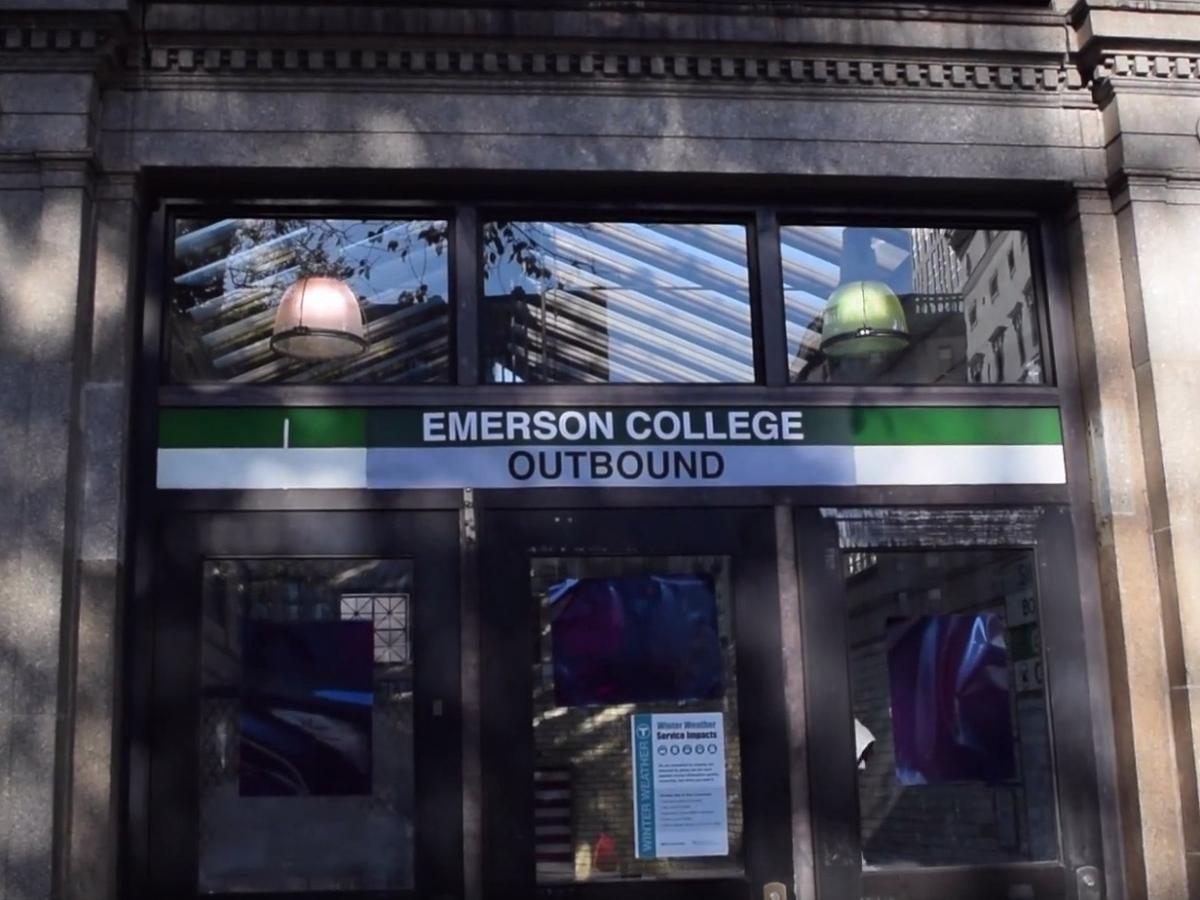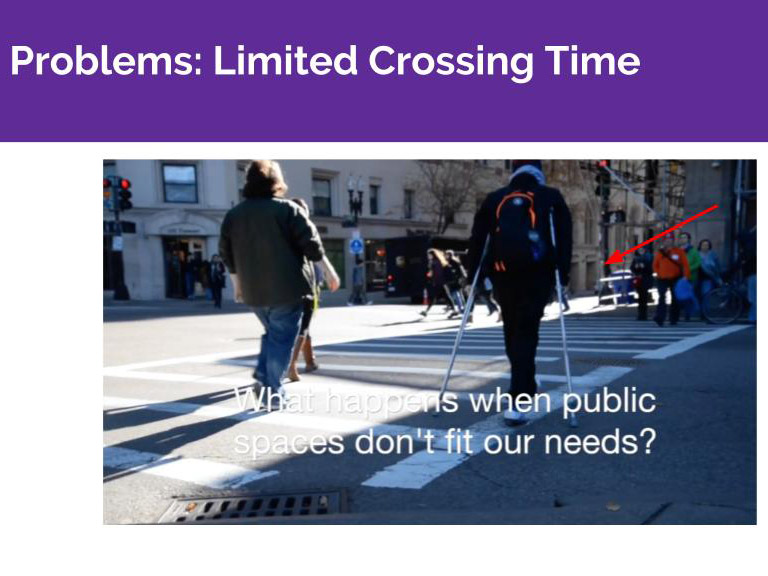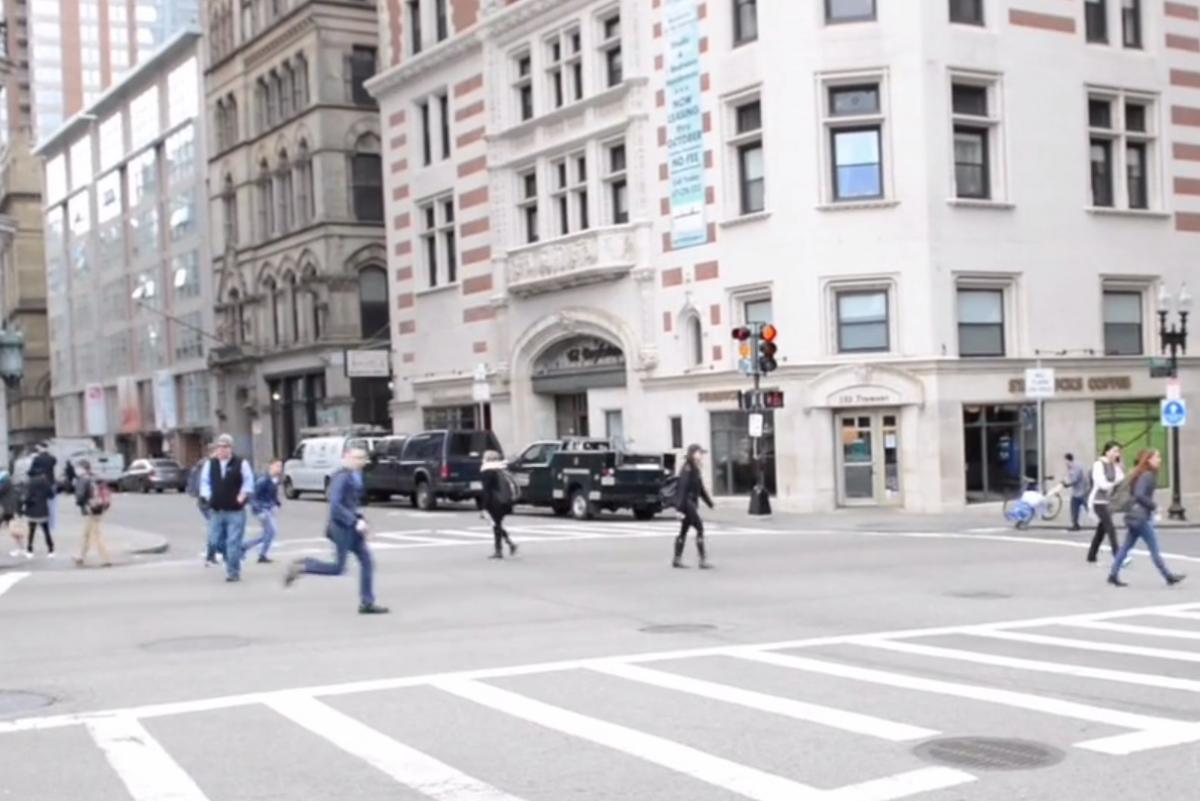Reimagination: Civic Design Course Tackles Notorious Intersection

The intersection of Boylston and Tremont streets has two big problems, according to students in Catherine D’Ignazio’s Civic Art and Design Studio course: It’s chaotic, and, despite it being right outside Emerson’s front door, it doesn’t feel like it’s part of the campus.
So for the last several weeks, the class has been trying to make the busy intersection safer, more efficient, and more “Emerson.” And true to the Emerson spirit (and the name of the course), the students used art, music, and a little guerilla marketing to envision a sane and symbiotic street corner.
“The civic engagement class gets students thinking about the design of public spaces and public services, and who gets to…participate,” said D’Ignazio, an assistant professor in the Journalism Department.
On Wednesday, December 7, the class presented their final proposals for the crossroads to a small audience of Emerson administrators; an architect working on the College’s facilities plan; and transportation officials from local government. The government representatives—Bonnie Polin, chief safety analyst with the Massachusetts Department of Transportation’s Highway Division, and Charlotte Fleetwood from the City of Boston’s Vision Zero traffic safety initiative—talked to the students earlier in the semester.
The class was divided into four groups, each of which tackled a different mode of using the intersection: public transportation, bicycles, cars, and pedestrians.
The public transportation group wants to rename the Boylston Street MBTA station on the Boylston/Tremont edge of the Boston Common to the “Emerson College” T station. Such a change would signal to students, commuters, and tourists that they’re in Emerson territory, much like the Green Line has done with Boston and Northeastern universities, and the Red Line has done with MIT and UMass Boston.
Iris Raiken ’18, Indigo Asim ’17, and Aren Kabarajian ’18 didn’t play around when it came to market testing. They made a mock banner that looked exactly like the actual sign over the Green Line station entrance (apart from the name) and slapped it over the real thing—for two hours.
“When we were putting it up, the T maintenance truck actually drove by and did nothing,” Karabajian said.
A lot of people didn’t seem to notice that anything was different, but Emerson students did catch the change and loved it. The group got more than 500 signatures on a change.org petition they circulated.
Fleetwood, with the city’s traffic safety initiative, said in real life, they would need to get community input for the name change, and Polin, from the state, said Emerson probably would need to pay a fair amount of money to the T for the honor, but both liked the idea and the pitch. Art Mombourquette, senior vice president for real estate at Emerson, said the proposal “really ties in perfectly with President Pelton’s goals” for campus cohesion.

The group studying pedestrian traffic—Kate Bartel ’17, Kelsey Aijala ’18, and Tori Knoerzer ’17—didn’t have as much success as the public transportation group with its petition to add five seconds to the crossing times at the corner. But thanks to an effective social media campaign and hashtag #Take5Emerson, the proposal got picked up by the Boston Globe and local TV stations, and President Lee Pelton agreed to fund a traffic study at the corner, D’Ignazio said.
“We’re kind of glad we took that route,” Bartel said of the social media campaign.
She said the focus of the initiative was to give more time to people with mobility issues, who currently must hurry diagonally across a wide, busy intersection. They were inspired by a group of students in Chinatown who worked with the Asian Community Development Corporation to increase signal times at Kneeland Street and Harrison Avenue for the large number of seniors who use the intersection.
Emerson Director of Student Accessibility Services Diane Paxton applauded the idea and added that it’s not always apparent who has a disability, and those people can be more vulnerable to traffic than someone using crutches or a wheelchair.

The day Annie Armstrong ’17 and Chantelle Bacigalupo ’17 observed the intersection, they saw many bicyclists disobeying the rules of the road.
“Bikers don’t know if they should behave like pedestrians or if they should behave like cars—and they should behave like cars… but they would do whatever was most convenient in that situation,” Armstrong said.
Taking their cue from crosswalks in Japan, the team decided to test out playing music to signal when pedestrians (and only pedestrians) were allowed to cross, as opposed to the ambiguous and easily ignored beeps that most Boston crossings use.
Using a soundtrack compiled by polling their fellow students (Queen’s “Don’t Stop Me Now” got the most votes), Armstrong and Bacigalupo serenaded citizens one windy day and gauged their responses. Verdict: Not much of an impact on cyclists, but it seemed to make the pedestrians happy.
“We did notice the mood at the intersection, which is very stressful, very aggressive, [changed],” Bacigalupo said. “There was more friendliness, more smiling.”
Polin, from MassDOT, said studies have shown people change their pace depending on the music they’re listening to, and that the students’ idea might induce pedestrians to move more efficiently.
“I’m actually going to bring this back [the the office] and see if we can test this out,” Polin said.
When Kira Venturini ’19 and Jacqueline Gaultieri ’18 observed the intersection to see how drivers behaved, they counted 152 obvious traffic violations in five hours. Part of the problem, they believe (apart from the notorious and exuberant aggression of Boston drivers) is that motorists don’t realize they are essentially driving through a college campus in that spot.
In an effort to better “brand” the intersection as Emerson, the team recommended a series of Emerson flags along Boylston at Tremont, similar to the banners on College buildings, but more visually engaging and at drivers’ eye level.
To spiff up the corner that is currently dominated by the Little Building’s scaffolding, the team embarked on a “yarn bombing” mission, and began wrapping as much of the scaffold’s iron bars with purple yarn as time and their budget would allow.
They learned too late that the yarn was not allowed (it’s flammable), so they had to unravel it, but the feedback they got was positive and they think their experiment proved a point.
“We were engaging in civic imagination,” Venturini said. “We were getting others to see the space as malleable.”
Bartel, who worked on the pedestrian team, said she was grateful for the class.
“I learned a lot about civic design and public spaces, and Catherine showed us a lot of cool grassroots campaigns that made it seem possible for citizens to make a change,” she said.

Categories